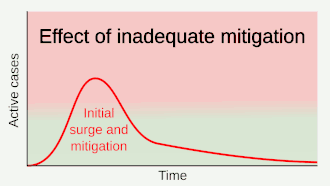Epidemic curve
An epidemic curve, also known as an epi curve or epidemiological curve, is a statistical chart used in epidemiology to visualise the onset of a disease outbreak. It can help with the identification of the mode of transmission of the disease. It can also show the disease's magnitude, its outliers, its trend over time, and its incubation period.[5][6] It can give outbreak investigators an idea as to whether an outbreak is likely to be from a point source (such as from a food handler), a continuous common source (with ongoing contamination), or a propagated source (that is transmitted primarily between people).[7][8]
.gif)
Epidemic curves generally show the frequency of new cases compared to the date of disease onset.[6]
Examples
Yellow Fever
2019–20 coronavirus pandemic
The first description of epidemiological curves from the 2019–20 coronavirus (COVID-19) pandemic showed the pattern of a "mixed outbreak". According to the investigators, there was likely a continuous common source outbreak at Wuhan Seafood Market in December 2019, potentially from several zoonotic events. As of the date of publication of the study, it is unknown which animal may have been the original reservoir of the virus, or how it was originally transmitted to humans. Following this, the investigators found that the outbreak likely became a propagated source, meaning that the virus became able to be transmitted from person to person.[9] The New York Times has published a curve simulator for both the USA and the world, on which the visitor can tinker the base parameters to get various outcomes.[10]
See also
- Infection control
- Social distancing
- Flatten the curve and raise the line
References
- Anderson RM, Heesterbeek H, Klinkenberg D, Hollingsworth TD (March 2020). "How will country-based mitigation measures influence the course of the COVID-19 epidemic?". Lancet. 395 (10228): 931–934. doi:10.1016/S0140-6736(20)30567-5. PMID 32164834.
A key issue for epidemiologists is helping policy makers decide the main objectives of mitigation—e.g. minimising morbidity and associated mortality, avoiding an epidemic peak that overwhelms health-care services, keeping the effects on the economy within manageable levels, and flattening the epidemic curve to wait for vaccine development and manufacture on scale and antiviral drug therapies.
- Qualls, Noreen; Levitt, Alexandra; Kanade, Neha; Wright-Jegede, Narue; Dopson, Stephanie; Biggerstaff, Matthew; Reed, Carrie; Uzicanin, Amra; Levitt, Alexandra; Dopson, Stephanie; Frank, Mark; Holloway, Rachel; Koonin, Lisa; Rasmussen, Sonja; Redd, Stephen; de la Motte Hurst, Christopher; Kanade, Neha; Qualls, Noreen; Rainey, Jeanette; Uzicanin, Amra; Biggerstaff, Matthew; Jernigan, Daniel; Reed, Carrie (21 April 2017). "Community Mitigation Guidelines to Prevent Pandemic Influenza—United States, 2017". MMWR. Recommendations and Reports. 66 (1): 1–34. doi:10.15585/mmwr.rr6601a1. PMC 5837128. PMID 28426646.
- Barclay, Eliza; Scott, Dylan; Animashaun (7 April 2020). "The US doesn't just need to flatten the curve. It needs to "raise the line."". Vox. Archived from the original on 7 April 2020.
- Wiles, Siouxsie (14 March 2020). "After 'Flatten the Curve', we must now 'Stop the Spread'. Here's what that means". The Spinoff. Archived from the original on 26 March 2020. Retrieved 13 March 2020.
- "Epidemic Curves". sphweb.bumc.bu.edu. Retrieved 2020-02-20.
- Torok, Michelle (2003). "Focus on Field Epidemiology" (PDF). North Carolina Center for Public Health Preparedness.
- "Using an Epi Curve to Determine Mode of Spread". Centers for Disease Control and Prevention.
- LaMorte, Wayne W. (2017-05-05). "Epidemic Curves". Descriptive Epidemiology. Boston University School of Public Health. Retrieved 2020-02-20.
- Zhang, Yanping (2020-02-14). "The Novel Coronavirus Pneumonia Emergency Response Epidemiology Team. The Epidemiological Characteristics of an Outbreak of 2019 Novel Coronavirus Diseases (COVID-19) - China, 2020" (PDF). China CDC Weekly. 2.
- Kristof, Nicholas; Thompson, Stuart A. (2020-03-25). "Opinion | Trump Wants to 'Reopen America.' Here's What Happens if We Do". The New York Times. ISSN 0362-4331. Retrieved 2020-04-10.
